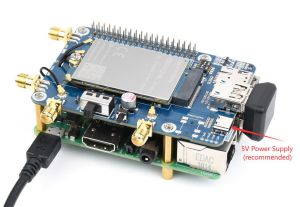Template: RM50X Raspberry Pi User Manual
Working with Raspberry Pi
Hardware Connection
Connect the 5G HAT with a double-ended usb3.0 data cable, and connect an external 5V power supply to the Type-C power supply port of the 5G HAT, as shown in the figure:
| Raspberry Pi | Pi 4B | Pi 3B/3B+ | CM4-IO-BASE |
|---|---|---|---|
| USB adapter | USB3.0 adapter | USB2.0 adapter | USB3.0 adapter |
| Connection |  |
 |

|
| Note | It is recommended to connect an external 5V power supply at the arrow.
| ||
If it is used for PI4B, there is a matching case, and the installation diagram is as follows:
The use of Raspberry Pi OS
This configuration is only needed for the first time.
Please download the newest Raspberry Pi OS, All the settings are based on Kernel 5.5, if you use the old version, please update first. Make sure your Kernel version is up-to-date, or else you may face issues with the driver.
5G ECM Mode Dial-up
Step 1. Uninstall Modem Manager and Network Manager
Open a terminal and run the following commands to uninstall Modem Manager and Network Manager:
sudo apt purge modemmanager -y sudo apt purge network-manager -y
Step 2. Test 5G Module
- Driver Testing:
Make sure the option USB-serial driver is properly loaded to the module interfaces. Check it with theusb-devicescommand.
pi@raspberrypi:~ $ usb-devices T: Bus=02 Lev=01 Prnt=01 Port=00 Cnt=01 Dev#= 3 Spd=5000 MxCh= 0 D: Ver= 3.20 Cls=00(>ifc ) Sub=00 Prot=00 MxPS= 9 #Cfgs= 1 P: Vendor=2c7c ProdID=0800 Rev=04.14 S: Manufacturer=Quectel S: Product=RM502Q-AE S: SerialNumber=377628d2 C: #Ifs= 5 Cfg#= 1 Atr=a0 MxPwr=896mA I: If#=0x0 Alt= 0 #EPs= 2 Cls=ff(vend.) Sub=ff Prot=30 Driver=option I: If#=0x1 Alt= 0 #EPs= 3 Cls=ff(vend.) Sub=00 Prot=00 Driver=option I: If#=0x2 Alt= 0 #EPs= 3 Cls=ff(vend.) Sub=00 Prot=00 Driver=option I: If#=0x3 Alt= 0 #EPs= 3 Cls=ff(vend.) Sub=00 Prot=00 Driver=option I: If#=0x4 Alt= 0 #EPs= 3 Cls=ff(vend.) Sub=ff Prot=ff Driver=qmi_wwan
- Execute
ls /dev/ttyUSB*, check if ttyUSB0~ttyUSB4 are recognized correctly. - Testing with AT command:
sudo apt-get install minicom sudo minicom -D /dev/ttyUSB2
Welcome to minicom 2.7.1 OPTIONS: I18n Compiled on Aug 13 2017, 15:25:34. Port /dev/ttyUSB2 Press CTRL-A Z for help on special keys AT OK
Step 3. Networking Setup with AT Commands
AT+QCFG="usbnet",1 AT+CGDCONT=1,"IPV4V6","YOUR_APN" AT+CFUN=1,1
Wait for the modem to boot again. It may take 30 seconds. Once the modem reboots, the minicom will be activated again.
After the reboot, open a new Linux terminal and check for usbX in the network interface using ifconfig or ipaddr commands.
- After rebooting the module, the NET indicator is on, and you can use the following commands to check the network. (Optional)
AT+QENG="servingcell"
- Use the following commands to get the IP and set up the DNS:
sudo dhclient -v usb0 sudo apt-get install udhcpc sudo udhcpc -i usb0 sudo route add -net 0.0.0.0 usb0
Step 4. Test 5G Network
After dialing, the Raspberry Pi can see usb0 get the ip by the following command, enter the command ifconfig usb0 or ifconfig.
- Now check the assigned IP address and test the connection.
ifconfig usb0
pi@raspberrypi:~ $ ifconfig usb0
usb0: flags=4163<UP,BROADCAST,RUNNING,MULTICAST> mtu 1500
inet 192.168.225.60 netmask 255.255.255.0 broadcast 192.168.225.255
inet6 fe80::8543:f6a0:e678:2e20 prefixlen 64 scopeid 0x20
ether 4a:aa:f8:62:36:bb txqueuelen 1000 (Ethernet)
RX packets 73 bytes 5047 (4.9 KiB)
RX errors 0 dropped 0 overruns 0 frame 0
TX packets 100 bytes 15116 (14.7 KiB)
TX errors 0 dropped 0 overruns 0 carrier 0 collisions 0
ping waveshare.com -I usb0
pi@raspberrypi:~ $ ping waveshare.com -I usb0 PING waveshare.com (104.26.11.134) from 192.168.10.27 usb0: 56(84) bytes of data. 64 bytes from 104.26.11.134 (104.26.11.134): icmp_seq=1 ttl=52 time=87 ms 64 bytes from 104.26.11.134 (104.26.11.134): icmp_seq=2 ttl=52 time=82 ms 64 bytes from 104.26.11.134 (104.26.11.134): icmp_seq=3 ttl=52 time=92 ms 64 bytes from 104.26.11.134 (104.26.11.134): icmp_seq=4 ttl=52 time=73 ms 64 bytes from 104.26.11.134 (104.26.11.134): icmp_seq=5 ttl=52 time=75 ms
Troubleshooting
Check if the module detects SIM:
AT+CPIN? # Should return READY
Check if the module is registered to the network:
AT+CEREG? # Should return 0,1 or 0,5
Check if the APN is correct and has an IP: AT+CGCONTRDP?
AT+CGCONTRDP # Should return APN details and IP address.
5G Network Speed Test
In the Linux system, you can install speedtest_cli to test:
## Raspberry Pi OS sudo apt install speedtest-cli speedtest # or use speedtest_cli
or
## OpenWRT opkg update opkg install python3 opkg install python3-pip pip install speedtest_cli speedtest # or use speedtest_cli


